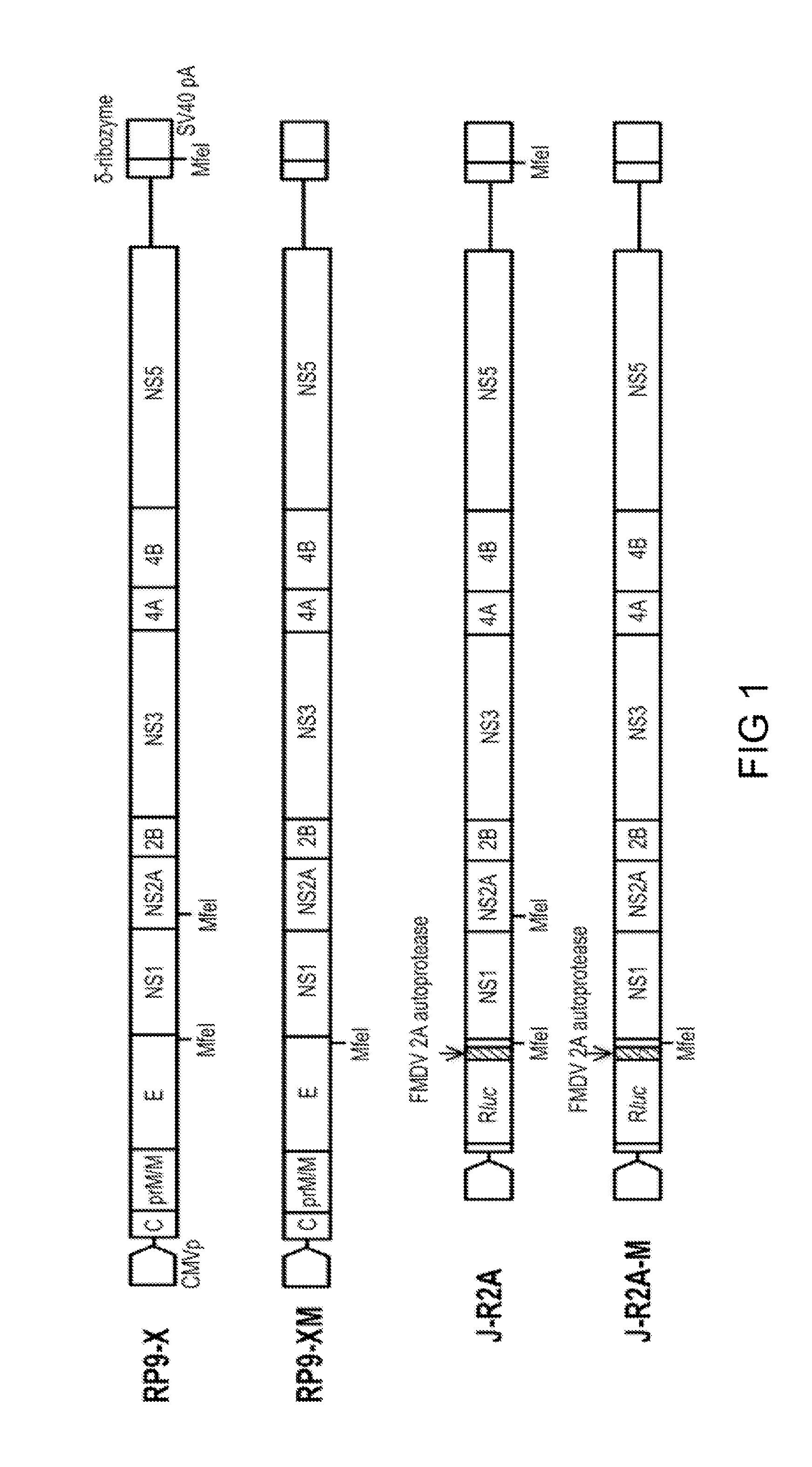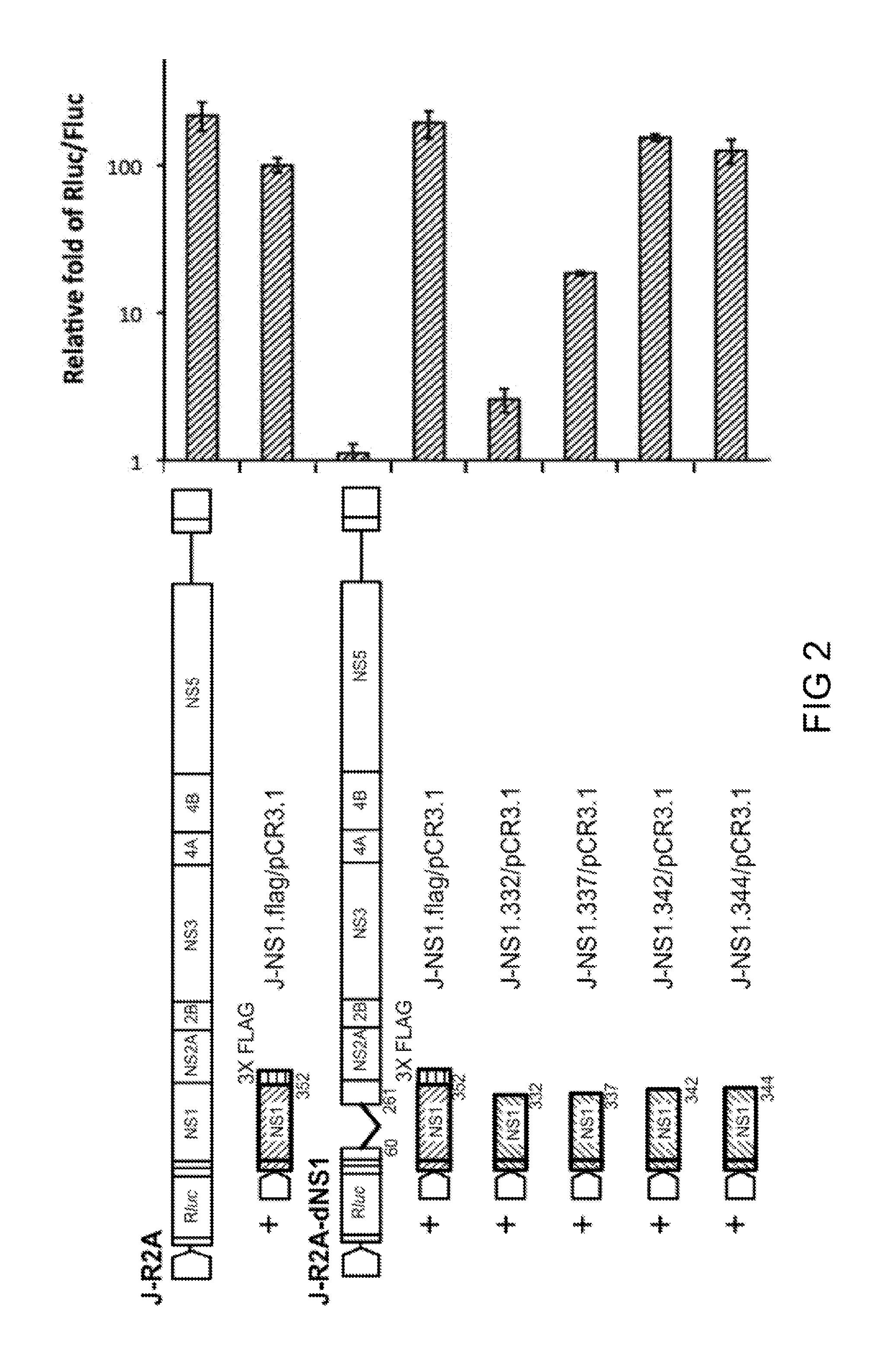Recombinant flaviviral constructs and uses thereof
- Summary
- Abstract
- Description
- Claims
- Application Information
AI Technical Summary
Benefits of technology
Problems solved by technology
Method used
Image
Examples
example 1
Generating Recombinant Japanese Encephalitis Viral (JEV) Constructs
[0073]The JEV replicon J-R2A was constructed by steps as described below. CMV-RP-9-ribo-polyA / pBR322, a full-length infectious cDNA clone of Japanese encephalitis virus of Taiwan strain (RP-9, National Center for Biotechnology Information (NCBI) access No: AF014161) was prepared in accordance with the method described previously by Liang et al (Vaccine (2009) 27: 2746-2754). This cDNA clone was used to construct JEV replicon, J-R2A (FIG. 1), in which structure genes of C-prM-E were removed and replaced by Renilla luciferase gene using jumping polymerase chain reaction (PCR). An FMDV-2A peptide sequence was then inserted behind the reporter gene so that Renilla luciferase may be precisely spliced with non-structure proteins after translation. Briefly, the C-prM-E gene of JEV cDNA clone was truncated using PCR. Primer prJE2388ApaKpnF (SEQ ID NO: 1, 5′-gagggcccatggtacc atgggcgtcaacgcacga-3′) and primer JE4507-4489 (−) (...
example 2
Characterization of the JEV NS1 Functionality by Use of NS1 C-terminal Truncated Mutants of J-R2A of Example 1
[0075]To study the relationship between JEV NS1 C-terminal amino acid and the NS1 functionality, several defective replicons J-R2A-dNS1 (i.e., NS1 C-terminal truncated mutants of J-R2A of Example 1) were generated and NS1 functionality of each defective replicon was analyzed by trans-complementation assays. Specifically, J-R2A-dNS1, and series of NS1 C-terminus truncated mutants including J-NS1.332 / pCR3.1, J-NS1.337 / pCR3.1, J-NS1.342 / pCR3.1, and J-NS1.344 / pCR3.1 were constructed. Each of the J-NS1 C-terminus truncated clones was subjected to trans-complementation assay, and 96 hrs after transfection, cell lysate of each clone was collected and replication ability of each clone was quantified by dual luciferase assay.
[0076]Briefly, 0.3 μg of each recombinant replicon DNA and 0.03 μg of pGL3 plasmid DNA, which served as the internal control, were mixed with 1.5 μl of Lipofecta...
example 3
Producing Fusion Protein Comprising JEV NS1 and Enterovirus 71 (EV71) SP70 Epitope
[0079]In this example, two restriction sites BssHII and PmII were first introduced into NS1 C-terminus amino acids 343 and 344 by single-primer mutagenesis, and the construct was denoted as J-NS1.BP.flag / pCR3.1. Replication ability of such clone was slightly lower than that of J-NS1.flag / pCR3.1 in trans-complementation assay. Meanwhile, an exogenous peptide, Enterovirus 71 (EV71) SP70 epitope (YPTFGEHKQEKDLEY) (Foo et al., (2007) Virus Res 125: 61-68) was inserted into the above-described J-NS1.BP.flag / pCR3.1, and the resulted clone was denoted as J-NS1.EV71.flag / pCR3.1. The replication ability of the EV71 SP70 fused J-NS1.343SP70.flag / pCR3.1 clone was found to reduce to about 50% in trans-complementation assay (FIG. 3). This reduction in replication ability may be due to the lengthening of C-terminus of NS1 or the conformational changes of the NS1.
[0080]Further, J-R2A-343SP70 (FIG. 4) was constructed ...
PUM
| Property | Measurement | Unit |
|---|---|---|
| Current | aaaaa | aaaaa |
| Length | aaaaa | aaaaa |
| Immunogenicity | aaaaa | aaaaa |
Abstract
Description
Claims
Application Information
 Login to View More
Login to View More - R&D
- Intellectual Property
- Life Sciences
- Materials
- Tech Scout
- Unparalleled Data Quality
- Higher Quality Content
- 60% Fewer Hallucinations
Browse by: Latest US Patents, China's latest patents, Technical Efficacy Thesaurus, Application Domain, Technology Topic, Popular Technical Reports.
© 2025 PatSnap. All rights reserved.Legal|Privacy policy|Modern Slavery Act Transparency Statement|Sitemap|About US| Contact US: help@patsnap.com



